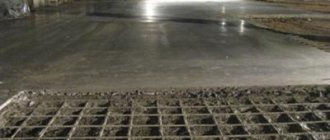Types of floors in the bathhouse
For baths characterized by high humidity and sudden temperature changes, as a rule, two types of floors are used:
- Wooden flooring.
- Concrete screed.
Concrete screed is often installed in steam rooms and washrooms. Ceramic tiles are usually laid on top of such a floor, choosing non-slip, durable and intended for rooms with high humidity levels.
Alternatively, when deciding how to cover the floor in a steam room, you can choose wooden lattice panels for laying on concrete, which will protect your feet from direct contact with the cold floor (pro
Types of surfaces and material
Perhaps you don’t want to read the entire article because you are interested in a specific answer to an equally specific question - which paint composition is applicable to this or that part of the room - the ceiling or floor, or walls.
Ceiling
There are no specialized paints just for the ceiling. Usually ceilings are painted with the same paint that is suitable for walls.
If you have wooden ceilings, you may decide to coat them with varnish or acrylate, like Tikkurilov's Supi Saunasuoya.
ATTENTION! Ceiling varnish is suitable without additives that increase its wear resistance, which reduces its price.
If you don’t want to preserve the look and texture of wood, you can use any wall paint. Just remember that in wet rooms you should use paints with special markings. These could be silicone or acrylic paints for bathrooms, for example.
Where it is dry, you can paint the ceiling in a bathhouse with ordinary water-based paint, as for a living room.
There are only flooring options that can be found in a bathhouse - wood or concrete. The latter is found in damp rooms; it is not always covered with tiles, but as an alternative to tiles it is covered with special paints, for example, paint for concrete pools, which guarantees resistance to water and good adhesion (sticking) specifically to this material.
Paint for concrete pools Hydrostone
As for the wooden floor, here you still have the same choice - either use an opaque composition, or a transparent one - that is, paint or varnish. If the bathhouse is used frequently, then it makes sense to look for a coating with special additives that reduce its abrasion (polyurethane, urethane). Otherwise, you can save money on this.
In principle, the floor is the coldest part even in a steam room, so your choice is not limited by anything (except for humidity, which should be taken into account). You can use alkyd varnishes and paints, even oil-based ones if you want. Yacht varnishes are designed for direct action of water.
The floor in the steam room can be covered with Finnish paints - there are impregnations, varnishes, and acrylate protection on sale.
For those who would like to read more detailed material on floor paints and varnishes, read this article.
The material of the walls themselves can be very different: wood, brick, blocks. However, they do not remain unfinished, so you will paint either timber/framework, or lining, or, less likely, plaster. The bathhouse is traditionally decorated with wood, but we will still tell you about all the existing options, in case it comes in handy for someone.
Proper work with coating
When processing wooden floors, it is very important to correctly set priorities and strictly adhere to the sequence of technological processes, otherwise the floor will not only turn out to be imperfect, but will also very quickly become unusable.
In addition, when choosing what to cover wooden floors in a bathhouse with, you should not purchase materials from unverified manufacturers with questionable quality, otherwise you risk completely replacing all wooden elements.
Processing and finishing of the boardwalk in the dressing room and other rooms of the bath includes the following steps:
- Applying an antiseptic to protect against mold.
- Finishing with paints and varnishes.
How to care for a painted steam room floor
The steam room is cleaned at least twice a month. In this case, it is advisable to adhere to the following sequence of work:
- Clean all vertical surfaces and benches from moisture, wiping thoroughly with a rag.
- Sweep the floor.
- Prepare a special solution of ammonia and water. It is important to maintain the proportion - for one liter of warm water - one tablespoon of ammonia (can be replaced with 9% vinegar).
- The wooden floor is washed like a deck, without lifting the mop they “draw” figure eights.
After cleaning, it is important to dry the floor properly. To do this, open the door and chimney dampers, and cover all containers with water.
Antiseptics
The main purpose of any antiseptic composition is to protect wood from rotting, mold, fiber destruction, and pest proliferation.
The operating conditions of any bath require constantly high humidity and high temperatures. All this has a detrimental effect on wood, so it is impossible to do without antiseptic treatment.
When choosing a suitable antiseptic, you should take into account that it must be intended specifically for use in baths, and also that it be produced by well-known companies on the market.
Impregnations are:
- Water soluble . This composition is optimal for treating walls in rest rooms and dressing rooms.
- With organic solvents . Surfaces treated with such impregnations acquire moisture resistance and increased strength. This composition is suitable for both interior and exterior decoration. In particular, if you don’t know how to treat the floor in a steam room, then this product is quite suitable for you.
- Oil based . Products from this category can only be used where there is no high humidity and no sudden temperature changes. You must first understand what is the best way to treat the bathhouse floor in your case.
- Combined use . The advantage of these compounds is that they simultaneously provide protection from both rot and fire.
Before treating the floor in the steam room or any other room in the bathhouse, you should thoroughly clean and dry the wood. Next, you should apply impregnation in several layers, paying special attention to the cut areas and joints. If damage by insects is detected, an alcohol-containing composition should be poured into the channels with a syringe, not forgetting the small area around the defective area.
However, it is a mistake to believe that one soak with an antiseptic will be enough. As the bath is used, any product is gradually washed away. Therefore, it is recommended to apply bath floor varnish over the antiseptic, preferably water-based.
Types of paints
Paints and varnishes have different chemical compositions, which affect their technical properties.
The following bath floor paint can be used:
- Dispersion acrylic
. Dries very quickly, protects wooden surfaces from moisture and mold formation. After applying this paint, the wood continues to “breathe”. The acrylic mixture is equally suitable for covering floors in both the relaxation room and the steam room. - Oily
. This paint does not withstand high temperatures and ultraviolet rays. When heated, it may change color and fade. Therefore, they cannot be used in the steam room or washing room. Oil paint can be used to paint oak, linden and other types of wood only if the room has moderate humidity and small temperature changes. - Water-based
. It is moisture resistant and does not release harmful chemicals when heated. A wooden floor coated with this composition will last more than 5 years. - Alkyd
. This paint is inexpensive. As a result of the influence of high temperature, it quickly loses its color and becomes dull. It is not suitable for treating floors in steam rooms and washing rooms. But in the rest room you can paint the surfaces with this paint.
Applying varnish
The final stage of finishing any room is varnishing. However, the materials necessary for treating surfaces in a bathhouse are subject to special, increased requirements (for more details: “Which varnish to choose for baths and saunas - the differences and advantages of different compositions”).
The varnish must provide:
- absence of rotting due to increased effects of antiseptic impregnation;
- protect floors from any damage, including mechanical;
- safety for the health of humans and their pets;
- resistance to high humidity;
- no toxic fumes due to overheating.
Before covering the floor in a steam room with any chosen varnish, you should pre-treat the surface, that is, clean the wood from grease, dirt, dust, and remnants of old paints and varnishes. All cracks and irregularities in the floor must be puttied and then treated with an antiseptic.
After this, you can apply the varnish using a brush or roller - whichever is more convenient for you. The varnish should dry thoroughly, after which another layer can be applied if necessary. Please note that in the steam room you can only use varnishes that do not contain toxic substances released into the air when heated. Another important point is that the varnish must protect the coating from accidental fire as a result of a spark from the oven.
Requirements for paints and varnishes for baths
Paints and varnishes that are intended to be used in rooms with high humidity must have special properties.
These properties include:
- moisture resistance;
- resistance to various temperatures;
- non-toxic;
- antifungal properties;
- resistance to mechanical damage.
Paints are also selected depending on what materials the floor is made of. If it is wood, then it is recommended to choose a paint color so that it emphasizes the natural grain of the wood without overlapping it.
How to paint a concrete floor in a bathhouse? For concrete, suitable compositions are those that remove dust from the surface and have good adhesive properties to mineral substrates. Otherwise, the protective layer will soon crack.
Floor painting
Floors in bathhouses are often not only varnished, but also painted in order to further extend the life of the coating. However, when choosing what to paint the floor in a bathhouse with, you need to take into account that the paint must be safe for health, that is, not release toxins when heated. In addition, in the steam room it is better to do without paint at all.
If you need a product to paint the floor of a bathhouse in a washroom, make sure it meets the following requirements:
- ensured the formation of a thin protective film on the surface after application, preventing the accumulation of moisture, dirt and excessive overheating;
- prevented fungal growth and mechanical wear.
Before painting the floor in the dressing room, you should perform all the same preliminary procedures as when varnishing the surface.
Important Tips
Some of the volatile components in the composition of impregnations can cause real harm to health, so they cannot be used in a steam room.
If necessary, you can carry out disinfection in a bathhouse with your own hands. However, many experts do not recommend using synthetic compounds for these purposes. Why? The temperature in the sink and steam room is often very high. It provokes the evaporation of antiseptic components from the surface of the floor or wall that has been treated with it. Some of the volatile components can cause real harm to health.
To prevent the negative effects of anti-putrefactive agents on the body, the choice of protective compounds must be approached with care:
- In the rest room and dressing room, the air temperature, as a rule, does not exceed 27 degrees. They can be used without problems with synthetic compounds;
- In the sink and steam room both humidity and temperature are high. To eliminate the possibility of volatile substances entering the body, it is better to treat logs, floor boards and other wooden elements with organic-based compounds.
https://www.youtube.com/watch?v=arjPqGew_ec
When choosing a paint and varnish mixture, you need to pay attention not only to the color and period of its service, but also to the following points:
- Specifics of wood covering. To process different types of wood, it is necessary to use different coloring compounds, which is determined by the structure and density of the material;
- Intensity of use. Oil mixtures have the greatest wear resistance, so they can be used in rooms with a high degree of load on the floors;
- Service period. The paint that will last the longest in a bathhouse is the one that is most resistant to moisture, i.e. based on acrylic or water emulsion.
It is worth considering that a change in paint color sometimes indicates imminent cracking of the coating. To prevent the wood from getting wet, it is advisable to re-paint the floors.
Method of application of anti-putrefactive agents
Before applying the product, the surface of the wood must be sanded.
So that the floor in the sauna does not rot over time and is not subsequently subjected to biological attack, you need to use protective compounds. But to achieve the best effect, you need to know how to apply them correctly. What points should you pay attention to when treating floors with your own hands?
- Before using the product, you should read the instructions provided by the manufacturer on the packaging;
- Before applying impregnation to logs and other wooden coverings, their surface must be dried and, if possible, sanded;
- Regardless of whether the floor covering is processed in a sink or a rest room, it must be applied in several layers;
- Materials are processed at temperatures above 5-7 degrees.
If traces of rotting have already appeared on the surface of the wood, you cannot do without special chemical treatment of the room. For these purposes, aggressive antiseptic agents are used that kill pathogenic flora.
Before painting, the floor surface is sanded and degreased.
Painting a rest room does not have any special restrictions in the choice of tinting compounds. Can water-based or oil-based mixtures be used to paint the floor? Since the rest room does not have a harsh microclimate, almost any type of paint and varnish mixtures can be used to treat the floor.
To prevent the painted surface from starting to crack within a couple of months after application, you need to paint the rest room as follows:
- The coating is cleaned of dirt and oil stains;
- The wood is first sanded to improve the adhesion of the paint to the floor surface;
- Before use, stir the paint and varnish mixture thoroughly;
- The paint is applied to the coating in several layers using a soft brush or roller;
- Oil stains that appear on the surface are removed with a sponge.











